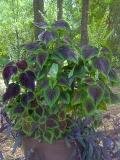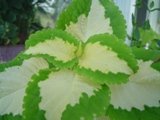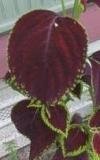





January is a gloomy month for those of us who live where the cold winters keep us cooped up in the house. The skies are often gray and dreary, the clouds heavy laden with snow. Even though the winter landscape is sparkling white and beautiful, it is a colorless beauty. What we need in January is color. Coleus seedlings are abundant with color. Try this winter project to brighten your day and lift your spirits.
 Starting coleus indoors is an enjoyable project to alleviate the gloom of winter. Native to certain tropics, coleuses add a tropical feel to any home during the icy months of winter. Coleus used as houseplants can be started any time. But if you intend to plant you coleus outdoors the general rule of thumb is to start them 10 weeks before the last frost date.
Starting coleus indoors is an enjoyable project to alleviate the gloom of winter. Native to certain tropics, coleuses add a tropical feel to any home during the icy months of winter. Coleus used as houseplants can be started any time. But if you intend to plant you coleus outdoors the general rule of thumb is to start them 10 weeks before the last frost date.
Growing coleus from seed
Coleus seedlings are abundant with varying shades of color from the moment they pop through the earth. Their vibrant colors are intensified when grown under fluorescent lights. An abundance of light is a must if you propagate coleus indoors in January. They require the additional light to encourage them to sprout. The January days will not be bright enough or long enough in the Northern climates to wake the coleus from their sleep. This is after all a winter project, so artificial lighting is a must. Growing with artificial lights is not as difficult as it seems.
 Your coleus seeds should sprout within ten to twelve days if sown in vermiculite or a fine potting soil mix. Use a flat or low tray which can be covered to retain moisture. Any material that light can pass through will work for a cover. Do not cover the tray too tightly. This may cause damping-off disease or mold growth. Keep the flat in a warm location. It is best not to place the flat in full sun. When seedlings are ready, plant them into individual pots.
Your coleus seeds should sprout within ten to twelve days if sown in vermiculite or a fine potting soil mix. Use a flat or low tray which can be covered to retain moisture. Any material that light can pass through will work for a cover. Do not cover the tray too tightly. This may cause damping-off disease or mold growth. Keep the flat in a warm location. It is best not to place the flat in full sun. When seedlings are ready, plant them into individual pots.
Propagating coleus from cuttings
 If you have a favorite cultivar of coleus you can propagate plants from it by taking softwood stem cuttings. First, choose a healthy stem. Locate a spot beneath a leaf node and cut the stem there with a knife or garden tool. I have often broken the stems with my fingers. It is not 'proper' gardening perhaps, but who among gardeners has not occasionally employed the finger-break method? Pick off the leaves along the bottom of the stem. Dip the cut end in rooting hormone and set into sterile potting soil. The stems will also root in moist sand. You might try using a vase of room temperature water to root your coleus. My mother often does this. The photo at the head of this paragraph is of my mother's coleus. To root the coleus in water, place the stems into the vase of water and change the water as needed until the roots appear. If you prefer potted coleus for transplanting into the garden take cuttings in fall and root them in water. Once the roots emerge plant them in pots. In spring you will have potted coleus to plant in your garden.
If you have a favorite cultivar of coleus you can propagate plants from it by taking softwood stem cuttings. First, choose a healthy stem. Locate a spot beneath a leaf node and cut the stem there with a knife or garden tool. I have often broken the stems with my fingers. It is not 'proper' gardening perhaps, but who among gardeners has not occasionally employed the finger-break method? Pick off the leaves along the bottom of the stem. Dip the cut end in rooting hormone and set into sterile potting soil. The stems will also root in moist sand. You might try using a vase of room temperature water to root your coleus. My mother often does this. The photo at the head of this paragraph is of my mother's coleus. To root the coleus in water, place the stems into the vase of water and change the water as needed until the roots appear. If you prefer potted coleus for transplanting into the garden take cuttings in fall and root them in water. Once the roots emerge plant them in pots. In spring you will have potted coleus to plant in your garden.
The facts
Scientific name: Coleus hybridus, Coleus blumei. It was recently renamed Solenostemon scutellarioides
Family: Lamiaceae (Labiatae) mints
Zones: All (as an annual)
Sun exposure: Shade to full sun
Moisture needs: Ample
Native habitat: The tropics of Asia, Africa, parts of Australia and the southern pacific.
Problems: Solenostemon scutellarioides is resistant to disease and insects. Stem rot and root rot can sometimes be a problem. Aphids, mealy bugs, and whiteflies are the main pests to watch for in your coleus.
Coleus is a tender perennial planted as an annual in non-tropic zones and often used as an indoor plant.
Some of the common names of Solenostemon scutellarioides include coleus, painted-nettle and jewels of the garden.
The vibrant world of coleus cultivars
 There are over 500 varieties of coleus in cultivation. Listed below is only a sample of coleus cultivars; you will find them and many others in PlantFiles.
There are over 500 varieties of coleus in cultivation. Listed below is only a sample of coleus cultivars; you will find them and many others in PlantFiles.
Sun loving coleus
'Alabama Sunset' has brick red leaves.
'Blair's Witch' has leaves that are burgundy to purple with yellow-green and red interlacing on the edges.
'Pineapple' is lime-green. The stems are burgundy.
'Plum Parfait' has ruffled, plum leaves and pink borders. The Victorians would have loved this one in their parlor.
'Solor Storm' has deeply sculpted leaves of rich red, green and off-white.
Coleus for partial shade
'Dark Star' is as dark as a moonless night.
'Purple Emperor' is royal purple to black and ruffled.
'India Falls' creates mounds of amethyst patterns. This is one of the carpet coleus.
'Sunset' has leaves of jeweled garnet.
'Thumbelina' is compact with small green and burgundy leaves.
Notes of interest
The Victorians were very fond of coleus.
As the coleus ages it has a tendency to become tall and thin. The vibrant colors will fade. Propagate your favorite cultivar by stem cuttings and continue enjoying it throughout the seasons to come.
Coleuses are the Victorian jewels of the garden. Bring them indoors before first frost to brighten up the parlor throughout the winter season.
Full sun will dull the foliage on some varieties of coleus. Other varieties show off their colors in sun. The varieties with more red pigment in the leaves are the most sun tolerant.
Useful links
Dave's Garden Coleus forum. There is ample information and help available at all Dave's Garden forums; this one is for subscribing members.
USDA Species Records of Solenostemon
Coleus at Wikipedia
Photo credits
Thanks to my mother and sister for sharing their coleus photographs for this article.
My garden
 ~Pleasant gardening
~Pleasant gardening
(Editor's Note: This article was originally published on October 1, 2008. Your comments are welcome, but please be aware that authors of previousl published articles may not be able to respond to your questions.)
Copyright © www.100flowers.win Botanic Garden All Rights Reserved